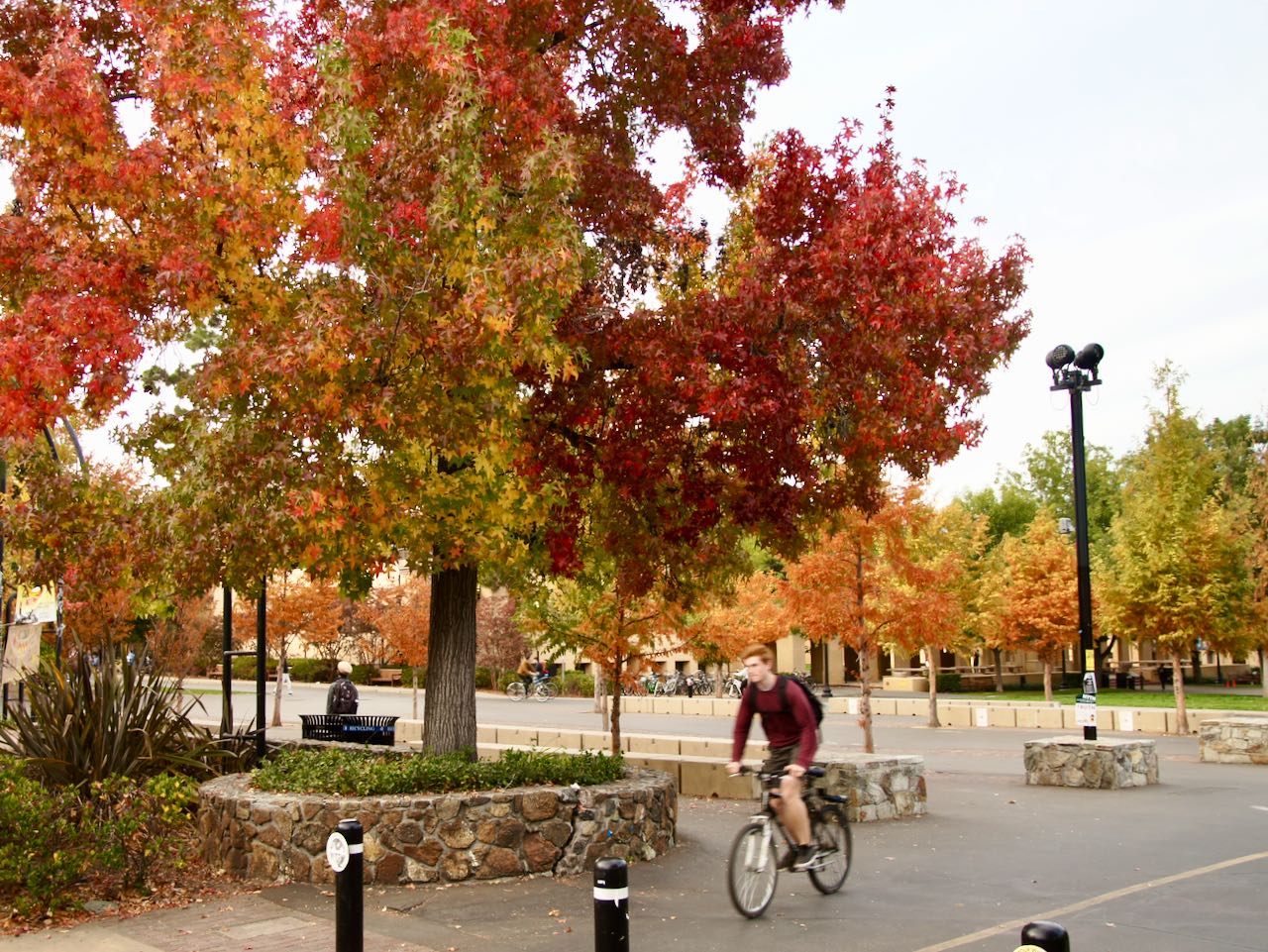Liquidambar styraciflua
 American sweetgum
American sweetgum

One of the most spectacular trees for fall color on campus, sweet gum, or liquidambar as it is often called, has become a frequent choice in landscaping projects on campus. Not only is the fall color attractive, a wonderful range of tints appearing even on one tree, but the colored leaves are long lasting. The foliage and general shape of the tree are also handsome in the summer. The five-lobed leaves are finely toothed, paler underneath, and have a little white fur where the stalk attaches. Separate male and female flowers without petals form clusters but are not very noticeable. However, the inch-size brown fruit balls dangling on their stems are a conspicuous feature. They are composed of large numbers of individual capsules containing winged seeds and are protected by sharp spikes left over from the old styles. The seed balls fall in quantity and are not pleasant to walk or cycle over.
Sweet gum received its name in reference to its fragrant resin, which has been used for chewing gum, mixing with tobacco, perfumery and, in 18th century England, as a medicine for “opening obstructions”; you can get a whiff of the pleasant odor by crushing a leaf. The phrase “possum up a gum tree” refers to the sweet gum. The wood is useful for craft projects.
L. styraciflua can be seen near the entrance to Green Library and north of Green Earth Sciences. Many are at Wilbur Hall and along Welch Road from Pasteur Drive to Quarry Road. A group grows at 904 Mears Court. There are lots on Lathrop Place.
Prior to 1960, sweet gums planted on campus were raised as seedlings, but now grafted varieties introduced by Saratoga Horticultural Research Foundation are used, mostly ‘Palo Alto’, a grove of which can be seen in the Amy Blue Garden between 651 and 655 Serra Street. ‘Burgundy’ and ‘Festival’ also have been planted on campus.
You may wonder what a winter-resistant deciduous tree like the sweet gum is doing in tropical Florida and South Texas. It is presumably because Arctic winds are funneled south between the Rockies on the west and the Appalachians on the east into a narrowing continent.
Adele Panofsky, known for creating the display of the skeleton of Paleoparadoxia at the Stanford Linear Accelerator Center, consulted me about replacing some of the honey-colored wood paneling of her home, which was known to have been sawn years ago from gum-wood, presumably eucalyptus, but which species? On my advice, she took a sample to the Forestry Research Institute in Sydney, one of few laboratories that can identify a tree from a wood sample without knowledge of the leaves, flowers, or fruits that characterize botanical texts. This ability came from the need to identify durable wood, cut years ago for posts and fences by farmers in New South Wales, when only the wood remained of trees that Dad had chopped down in his youth. Coming back the next day, Adele learned that her gum paneling was American sweet gum! Good marks to the lab! Tree identification from wood samples is offered free by the Forest Products Laboratory, Madison, Wisconsin.
Illustrations: gallery.
About this Entry: The main text of this entry is from the book Trees of Stanford and Environs, by Ronald Bracewell, published 2005. Family changed from Hamamelidaceae to Altingiaceae; sweet gum combined into one word, a common spelling, in the title only (not in the entry text); Forest Products Lab URL updated (Oct 2017, SP).






